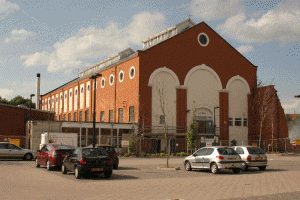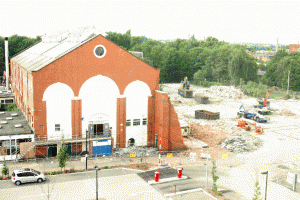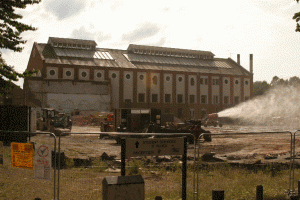THE LERO BUILDING
The Lero was built in 1904 to house the generating equipment that provided the electricity for the City’s tramway system. It was constructed near to the canal so as to be within reach of coal supplies that were needed to feed the large boilers and water which was required for the steam engines.

The name ‘Lero’ is thought to date back to medieval days. A mid-eighteenth century map reveals the site as a twelve-acre field called ‘The Leroes’. In the corner of the field was a small lime kiln. This field was owned by the Freemen of Leicester for the grazing of pack-horses, but it was later sold for the construction of the Grand Union Canal. A depot and basin was put in to handle the coal and general freight traffic carried via the waterway system. The canal company closed the lime kiln but the name is carried on at the canal lock-gates which are now known as Lime Kiln Lock. The remaining land was then sold to Leicester Corporation, and a plot of just over two acres became the site for their new tramway electricity supply station.
The Building:
The Lero building was constructed with an entrance facing Painter Street, that served as the main engine room. It was 118ft long by 60ft wide and 40ft high to the eaves. The engine room floor was of mosaic, and the walls were of glazed tiles in patterns, giving a very fine appearance. Three big 500kw steam generating sets were installed, standing approximately 20ft high and 28ft long, and provision was made for adding a fourth set of 1000kw when necessary.
The engines were of Yates and Thom’s Vertical Cross-Compound Corliss Condensing type, having cylinders placed at opposite ends of the crankshafts, with the cranks set at 90 degrees to each other. The flywheel, 16ft in diameter and weighing 25tons, was placed together with the generator between the two vertical engines, all fastened onto a massive cast bedplate. The engines themselves were almost totally enclosed, thus keeping the engine room very clean.
The principle dimensions of the engines were:
Working pressure: 160psi
Cylinder Bores: High pressure 22ins – Low Pressure 44 ins
Stroke: 3 feet
Flywheel Diameter: 16 feet Weight 25 tons
Valve Gear: Corliss Double Ported
Revs Per Minute: 95
Generators: Dick-Kerr 500 KW Compound Wound
Voltage: 500-550v DC
Normal load of each engine was 500 KW, but they were designed to drive an overload of 25 per cent for two hours and to sustain 50 per cent temporarily.
The engines were fitted with very powerful and sensitive governors having various special devices attached for electrical generating engines dealing with largely varying loads, and for ensuring good parallel running with other engines. These governors would also stop the engine in the event of 10 per cent over-speed being reached or if the governor failed, while at the same time it did not interfere with the engine taking excessive overloads, even beyond the full range of the valve gear cut-off.
The boiler house was 108ft long and 77ft with provision for eight boilers, and was adjacent to the canal basin. Coal was brought by barge and unloaded by crane onto a conveyor system. In 1904 there were four boilers installed, of the Lancashire type, built by Yates and Thom, 33ft long by 8ft 5inches diameter, with two flues 3ft 5inches diameter. The shell plates were thirteen-sixteenths of an inch thick and the end plates three-quarters of an inch thick. The working pressure was 160psi and the boilers were tested at 260psi; they were fired by Bennis Automatic Stokers.

The massive brick chimney was 186ft high and octagonal in shape, 20ft at ground level and 11ft at the top; the internal flue was 8ft 6inches diameter throughout and was lined with firebrick. The foundations were carried down to a depth of 17ft into the solid red marl. At the time, this chimney was the largest in Leicester and was a real landmark.
The three Direct Current generators were supplied by Dick-Kerr and were direct-coupled between the high pressure and low pressure engines of each set. The generators were compound wound, of 500 KW when running at 95 revs per minute, at a voltage of 500-550 volts DC.
The battery had a special room and was composed of 240 cells of the standard Tudor Pattern; it was capable of giving 600 amperes for one hour or 900 amperes for short periods. It could be charged normally at 270 amperes, or 450 amperes for short periods. The cells were in lead-lined wooden boxes resting on glass oil insulators. The stands were of pitch pine without any metal fastenings, and they rested on large porcelain insulators to ensure perfect insulation of the whole battery from the earth , which is an important point in traction batteries where one pole is directly connected to earth. This battery was used in connection with a reversible booster controlled by means of R Thury’s Patent Regulator.
Operation:
The Power Station was officially opened on 18th May 1904 as part of the tramway systems official opening proceedings. After arriving by horse tram, the power was switched on by Mrs Flint (wife of Councillor Samuel Flint, Chairman of the Tramways Committee) and Mrs Smith (Alderman Smith, the Vice Chairman’s Lady). The party of dignitaries were then conveyed to the new Abbey Park Road Depot by electric tram where they then transferred to three decorated trams for a ceremonial tour of Belgrave and Stoneygate.
In 1906 the additional space built for increased capacity was put to use and the Lero was operating at full strength with three 500 kW and one 1000kW generators in service.
By 1908 it was decided that 20% of the electricity produced could be sold to industries in the town. This was taken to consumer’s premises from the overhead wire and then returned to the track. It was an arrangement that worked well until there was occasion to interrupt the supply while repair work was undertaken! (Such work was often carried out on Sundays for obvious reasons). Prior to this the only electricity available to consumers was from a small power station situated within the Gas Works on Aylestone Road; the limited supply from here was available for lighting only.
By 1910 the engine house was lengthened by 53ft 6ins and a Willans & Robinson turbine and Siemens 1000kW DC generator were commissioned. In order to meet a demand for AC, a 750kW alternator driven by a DC motor was also installed.
The Lero and the Aylestone Gas Works generating site were eventually coupled together in 1914; The sites being managed together under the unified control of the Tramways and Electricity Committee. As the City expanded so too did the demand for supply; to such an extent that there was no longer room for expansion at the Lero premises.
Displacement:
Leicester’s new Electricity Generating Station opened on Freemans Meadow (now the site of Leicester City Football Club’s Walkers Stadium) in December 1922 and plans were already in place to feed the tram system from a 3 phase supply via rotary converters. These converters were housed on Sanvey Gate and Newarke St.
The new generating station with its 41,750kW output displaced the need for The Lero and the Aylestone Works and The Lero was closed on 30th June 1930. The building was however retained until 1938 when it was transferred to the Education Department.
Educational Role:
The Lero was then adapted for education purposes and formed part of the Leciester College of Technology. It subsequently became Charles Keene College and in 1999 it merged with Leicester Southfields to become Leicester College. As their Abbey Park Campus, it housed the Performing Arts, Music and Engineering departments. In Nov 2007 ‘The Lero’ was sold for redevelopment becoming surplus to the college’s requirements following the construction of a new campus adjacent to the site. The site had been kept secure and un-vandalised since its closure to students and on 14th June 2010 it was noticed that the stone steps leading up to the original Lero entrance had already been removed. By the 17th June 2010 the majority of the surrounding small buildings had been demolished. I am sure it will not be long now before work begins on the Lero building itself and by the end of July 2010 it is likely to be no more.

UPDATE: 19/07/2010
The last remaining part of the Lero (the frontage) was pulled down today. The site is now just rubble.
Tragic that such a fine building should be pulled down. I expect the developers will pull out, just as at Abbey Park Road depot. Does Leicester not care for its heritage?
I went here as Charles Keene college as an electrical apprentice 30 odd years ago. Used to love exploring the passages downstairs, even then it had an air of history. What a tragedy it is gone, and I agree one day we will question how we could have let such an important part of Leicester’s heritage go.
Everything good goes in Leicester. It may be a prosperous city but it has no soul, it loves money far too much. Just take a look at Nottingham, so much has survived including one very beautiful old Theatre and the city centre has character. Then compare Leicester, all brand new and somehow inpersonel. I do believe the city council want Leicester to be thought well of, but they so often miss the mark completely. Perhaps they might buck the trend with Tram car 31 and let it run on reserved track down the centre of Charles Street to the Curve. That would be inovative……………forget it … no chance!
Dear Barry, thanks for your post!
What a thought eh? Car 31 on its way to the cultural quarter! I agree its unlikely, …. but i’d like to see the artists impression!!
Steve.
About 50 years ago I worked as a technician/lecturer at Charles Keene. I noticed that in the forecourt of the old Lero building there was standard gauge tramway track leading to the centre archway. It disappeared under the tarmac down Painter Street.
I have never seen this track mentioned anywhere and it does not appear on any of the usual tramway maps. Perhaps a study of the relevant large-scale OS map from the the pre-WWI years would throw some light on it?
Oh well!!! Here we go again,
How sickening, why does the Council allow these developers to get away with pulling down such a building that has such History, just for profit I suppose? An original Tram Station that generated its own DC Power for the Trams, and also sold off some off to the Local businesses. I also went to Charles Keene College in the Lero building before going to Leicester Poly. It was useful then, I’m sure it would be useful now. If we ever have a new Tram system, people will wonder why the hell the planners allowed this historic building to be pulled down. This is almost on a par with the developers pulling down the Blue Boar Pub with all its history…. Stef Richo.
Yes, I totally agree with all the previous comments. Especially the previous reply. They sometimes say it is a small world, please allow me to explain. Whilst surfing the web for the history of the educational institutions of which I attended in my youngr years in the UK. I find out that the previous reply happens to be my twin brother. We both attended Charles Keene college from 1960 to about 1967 wherebye we spent several more years (him more than I) attending Leicester Poyltechnic before I emigrated to South Africa. The article above, is truly facinating and I thank the researchers for its compilation. Shame on those that decided to demolish the building. Mick Richardson S.A.